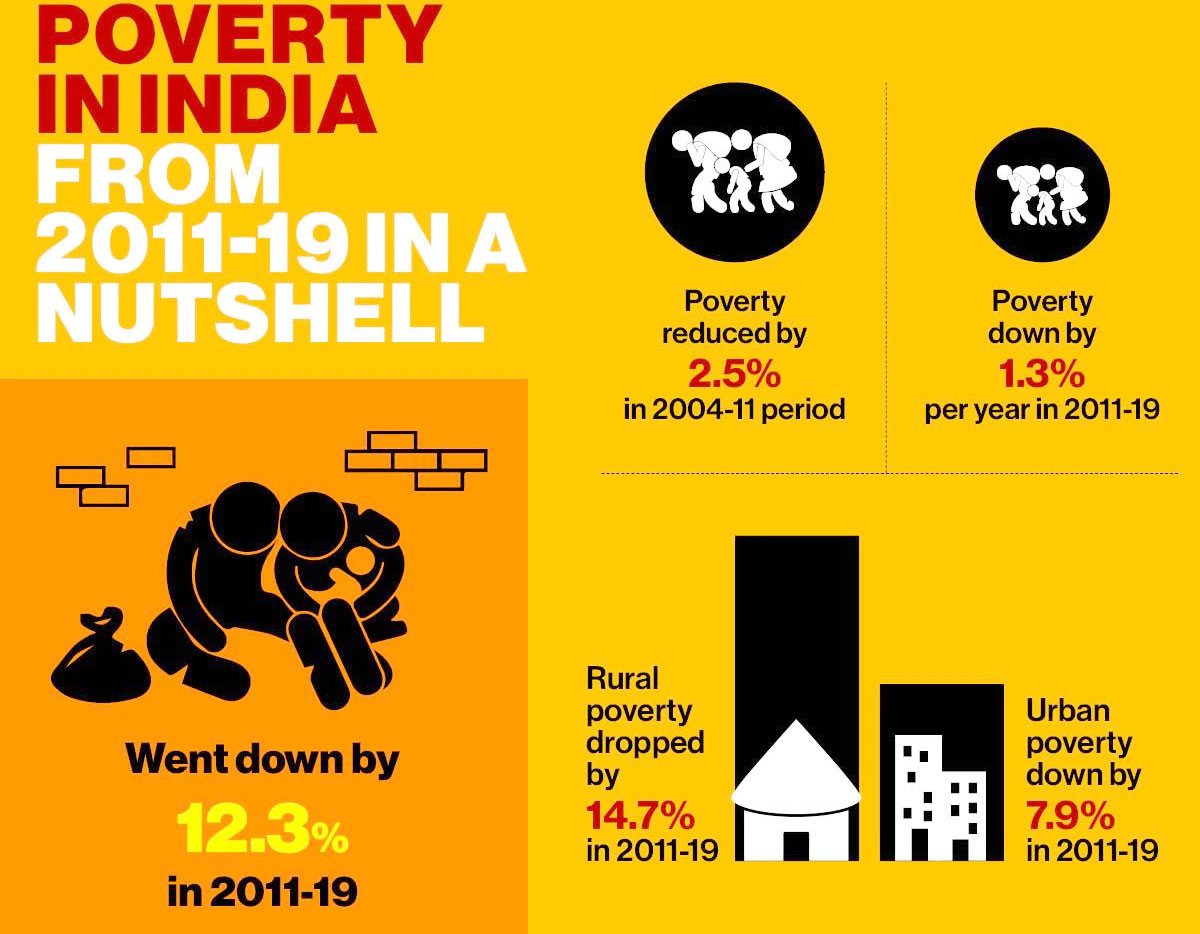Note4Students
From UPSC perspective, the following things are important :
Prelims level: Poverty in India
Mains level: Paper 2- Poverty reduction in India
Context
A recent World Bank Report has shown that extreme poverty in India more than halved between 2011 and 2019 – from 22.5 per cent to 10.2 per cent. The reduction was higher in rural areas, from 26.3 per cent to 11.6 per cent.

What explains the reduction in poverty?
- Poverty has reduced significantly because of the government’s thrust on improving the ease of living of ordinary Indians through schemes.
- These schemes include the Ujjwala Yojana, PM Awas Yojana, Swachh Bharat Mission, Jan Dhan and Mission Indradhanush in addition to the Deendayal Antyodaya Yojana-National Rural Livelihood Mission and improved coverage under the National Food Security Act.
- It is important to understand how poverty in rural areas was reduced at a faster pace.
- Much of the success can be credited to all government departments, especially their janbhagidari-based thrust on pro-poor public welfare.
Contributing factors
1] Identification of beneficiaries through SECC 2011
- The identification of deprived households on the basis of the Socioeconomic and Caste Census (SECC) 2011 across welfare programmes helped in creating a constituency for the well-being of the poor, irrespective of caste, creed or religion.
- Deprivation criterion: Since deprivation was the key criterion in identifying beneficiaries, SC and ST communities got higher coverage and the erstwhile backward regions in Bihar, Madhya Pradesh, Rajasthan, Uttar Pradesh, Jharkhand, Odisha, Chhattisgarh, Assam, Rajasthan and rural Maharashtra got a larger share of the benefits.
- Gram Sabha Validation: Social groups that often used to be left out of government programmes were included and gram sabha validation was taken to ensure that the project reached these groups.
2] Widened coverage of women
- The coverage of women under the Deendayal Antyodaya Yojana and Self Help Groups (SHG) increased from 2.5 crore in 2014 to over 8 crore in 2018 as a result of more than 75 lakh SHGs working closely with over 31 lakh elected panchayati raj representatives, 40 per cent of whom are women.
- This provided a robust framework to connect with communities and created a social capital that helped every programme.
- The PRI-SHG partnership catalysed changes that increased the pace of poverty reduction and the use of Aadhaar cleaned up corruption at several levels and ensured that the funds reached those whom it was meant for.
3] Creation of basic infrastructure
- Finance Commission transfers were made directly to gram panchayats leading to the creation of basic infrastructure like pucca village roads and drains at a much faster pace in rural areas.
- The high speed of road construction under the Pradhan Mantri Gram Sadhak Yojana created greater opportunities for employment in nearby larger villages/census towns/kasbas by improving connectivity and enhancing mobility.
4] Availability of credit through SHGs
- The social capital of SHGs ensured the availability of credit through banks, micro-finance institutions and MUDRA loans.
- Livelihood diversification: The NRLM prioritised livelihood diversification and implemented detailed plans for credit disbursement.
5] Implementation of social sector schemes
- In the two phases of the Gram Swaraj Abhiyan in 2018, benefits such as gas and electricity connections, LED bulbs, accident insurance, life insurance, bank accounts and immunisation were provided to 63974 villages that were selected because of their high SC and ST populations.
- The performance of line departments went up manifold due to community-led action.
- The gains are reflected in the findings of the National Family Health Survey V, 2019-2021.
6] Universal coverage schemes
- The thrust on universal coverage for individual household latrines, LPG connections and pucca houses for those who lived in kuccha houses ensured that no one was left behind. This created the Labarthi Varg.
7] Increase in fund transfer to rural area
- Seventh, this was also a period in which a high amount of public funds were transferred to rural areas, including from the share of states and, in some programmes, through extra-budgetary resources.
8] Community participation
- The thrust on a people’s plan campaign, “Sabki Yojana Sabka Vikas” for preparing the Gram Panchayat Development Plans and for ranking villages and panchayats on human development, economic activity and infrastructure, from 2017-18 onwards, laid the foundation for robust community participation involving panchayats and SHGs, especially in ensuring accountability.
9] Social and concurrent audit
- Through processes like social and concurrent audits, efforts were made to ensure that resources were fully utilised.
- Several changes were brought about in programmes like the MGNREGS to create durable and productive assets.
10] Focus of states on improving livelihood diversification
- The competition among states to improve performance on rural development helped.
- Irrespective of the party in power, nearly all states and UTs focussed on improving livelihood diversification in rural areas and on improving infrastructure significantly.
Conclusion
All these factors contributed to improved ease of living of deprived households and improving their asset base. A lot has been achieved, much remains to be done.
UPSC 2023 countdown has begun! Get your personal guidance plan now! (Click here)
Get an IAS/IPS ranker as your 1: 1 personal mentor for UPSC 2024
